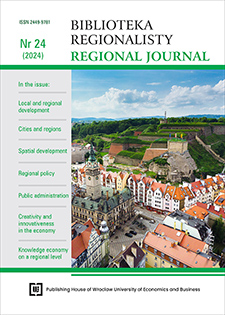The phenomenon of shrinking Polish cities – essence, causes and effects
DOI:
https://doi.org/10.15611/br.2024.1.09Keywords:
city, population, phenomenon of urban shrinkage, restructuringAbstract
Aim: Identification of factors influencing the shrinking of cities, future forecasts, the essence of the problem.
Methodology: Numbers of inhabitants, birthrate and migration in selected cities with over 100 000 inhabitants in the period 2014-2023 were the subject of a descriptive analysis.
Results: Based on the conducted analysis it can be concluded that the phenomenon of shrinking Polish cities with more than 100 000 inhabitants is a strongly progressive phenomenon that affects their various social, economic and business spheres. The impact of this phenomenon on the size of natural increase, migration and age structures is underlined.
Implications and recommendations: The Polish cities with more than 100 000 inhabitants selected for the analysis are subject to the phenomenon of shrinkage due to many demographic, social, economic and urban factors. Each city has different individual reasons for shrinkage, however the common deno-minator for these reasons is taking effective actions to stop this negative trend.
Originality/value: The phenomenon of shrinking Polish cities is an original topic due to the unique conditions in terms of the country’s economy, history and society. In addition, this phenomenon is dis-tinguished by its multi-aspect nature in various regions of Poland. In Poland, the phenomenon of urban shrinkage is becoming increasingly significant. However, this topic is still insufficiently explored and requires further research, which makes it even more original.Downloads
References
Cienkosz, E. (2020). Demograficzny aspekt kurczenia się polskich miast. Urban Development Issues, 67(1), 45-56. https://doi.org/10.2478/udi-2020-0033
Haase, A. (2013). No one-size-fits-all. O różnorodności kurczących się miast w Europie. W: Zarządzanie rozwojem miast
o zmniejszającej się liczbie mieszkańców (w kontekście perspektywy finansowej 2014-2020) (s. 31-44). Kancelaria Senatu. https://www.senat.gov.pl/gfx/senat/userfiles/_public/k8/agenda/seminaria/2013/130301/zarzadzanie_rozw_mias.pdf
Kowalewski, A. Wykład wprowadzający. W: Zarządzanie rozwojem miast o zmniejszającej się liczbie mieszkańców (w kontekście perspektywy finansowej (2014-2020) (s. 107-120). Kancelaria Senatu. https://www.senat.gov.pl/gfx/senat/userfiles/_public/k8/agenda/seminaria/2013/130301/zarzadzanie_rozw_mias.pdf
Musiał-Malago, M. (2017). Przestrzenne zróżnicowanie procesu kurczenia się miast w Polsce. Prace Naukowe Uniwersytetu Ekonomicznego we Wrocławiu, 467, 70-81.
Musiał-Malago, M. (2018). Wybrane aspekty kurczenia się miast w Polsce. Studia Miejskie, 29, 61-75.
Stryjakiewicz, T. (2014). Kurczenie się miast w Europie Środkowo-Wschodniej. Wydawnictwo Naukowe Bogucki.
Downloads
Published
Issue
Section
License
Copyright (c) 2025 Agata Gałka

This work is licensed under a Creative Commons Attribution-ShareAlike 4.0 International License.
Accepted 2025-01-27
Published 2025-01-31







